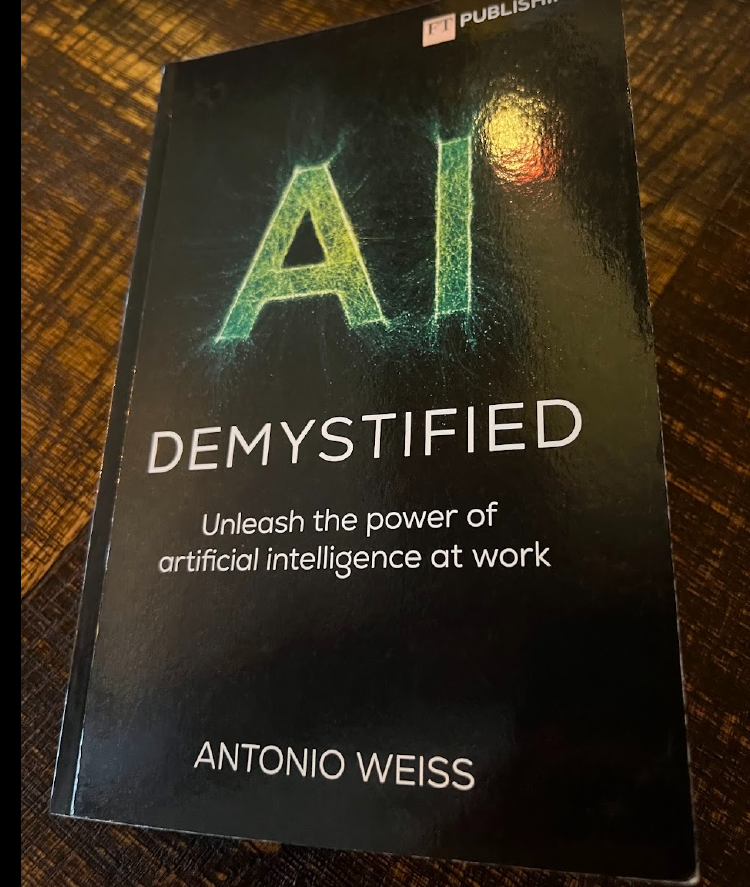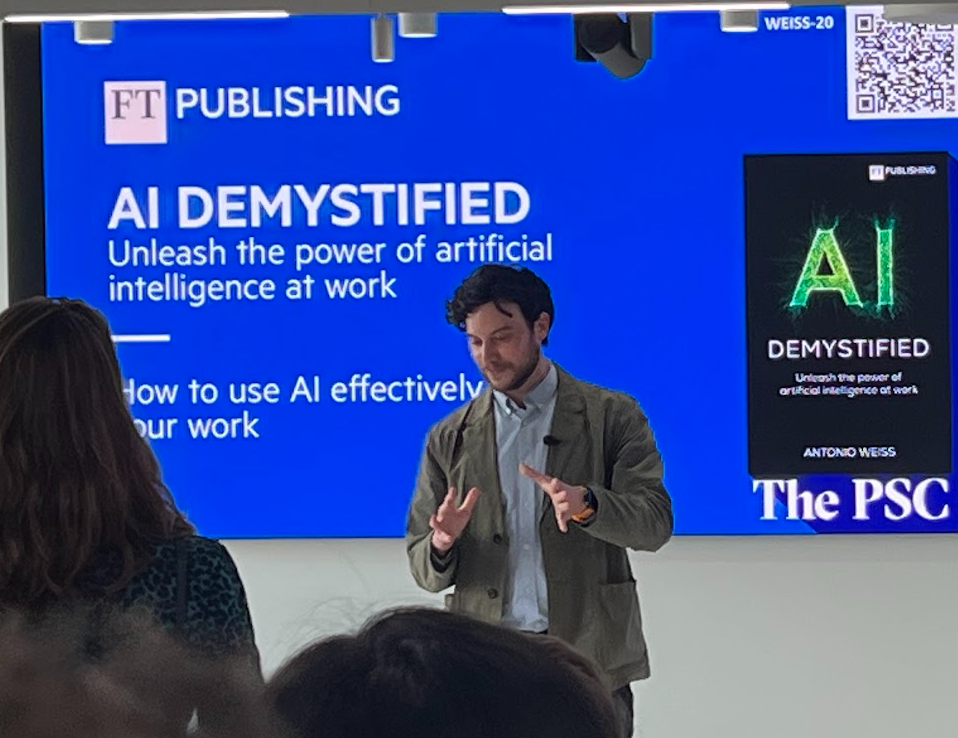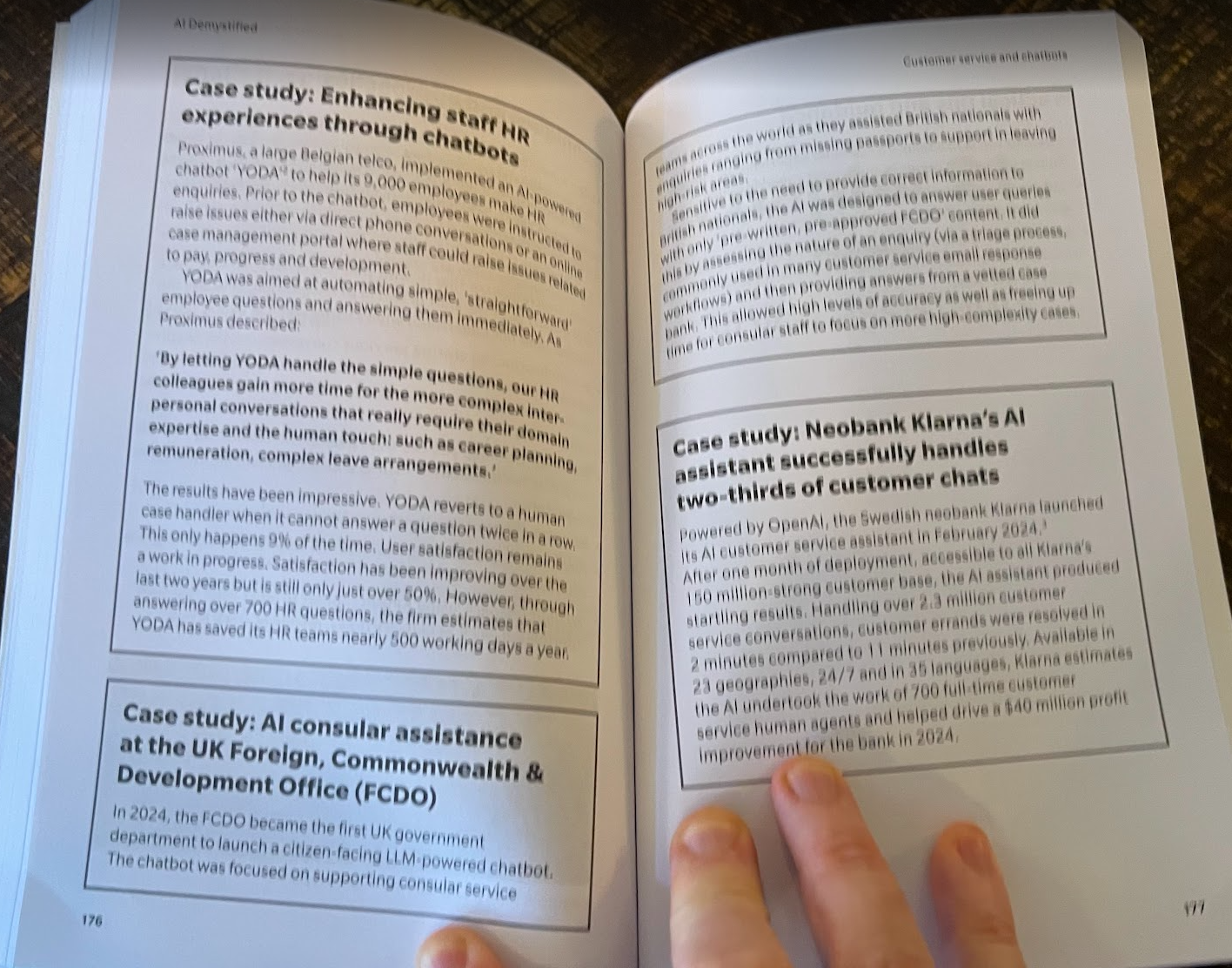AI Demystified Book by Antonio Weiss
Pearson FT published AI Demystified offers a gentle introduction for business leaders who want to understand how AI might impact their field.

- David Gérouville-Farrell
- 6 min read

Because I’m obsessed with AI, I go to as many AI-related events in London as I can. I blagged a ticket to the launch of Antonio Weiss’s “AI Demystified,” which was held in the swanky Financial Times Pearson building on the Strand. After getting a copy of the book, I discovered that a project I’d worked on was featured in it. Naturally, that gave me an extra incentive to actually read the thing.
 Antonio Weiss’s AI Demystified book launch
Antonio Weiss’s AI Demystified book launch
But beyond self-aggrandisement, I think there are a few valuable bits worth sharing from the book. This is especially true for people who are less deeply enmeshed in the AI world and are wondering how they can position themselves and their organisation to adapt successfully to this rapidly changing landscape.
Horizontal vs Vertical AI Transformation
Weiss provides a useful framework for thinking about the scope of AI implementation. He distinguishes between horizontal and vertical approaches:
Horizontal transformation involves changing entire end-to-end workflows. His example is Octopus Energy, which uses AI to handle over a third of customer emails with an 80% satisfaction rate. The AI manages complete customer interactions from initial contact through resolution, with productivity gains equivalent to 250 staff members. This approach also provides scalability during demand spikes, such as meter reading days when enquiries increase significantly.
Vertical transformation focuses on enhancing expertise within a specific domain or professional area, rather than changing the overall process. According to research from Imperial College London, AI tools can detect up to 13% more cancers than human radiologists in mammogram screenings. The AI doesn’t change the overall diagnostic workflow but significantly enhances one crucial component.
Weiss’ Verb Exercise to Prioritise AI Opportunities
If you haven’t brought AI into your organisation yet, one way you might want to do so would be through what Weiss calls the “verb exercise.” The approach is straightforward: for any task you’re doing - writing, researching, interviewing, generating concepts - list the active verbs that consume the most time. These might include:
- Imagining new landscapes
- Writing interview guides
- Summarising interviews
- Searching for information
- Generating concepts
The next step involves asking how generative AI might assist with these time-consuming activities. It’s straightforward, but it can bring your attention to good candidates for AI automation without getting lost in low-value opportunities.
 The FCDO Consular Assistance Project that I worked on
The FCDO Consular Assistance Project that I worked on
We used a slightly different methodology, but basically that’s why the FCDO Consular Assistance Project was the first use case the Foreign Office focused on. The amount of time spent and the number of members of staff whose entire days were filled with answering routine email enquiries meant that it was a good candidate for bringing AI in. That project is now launched across all UK Embassy pages internationally, and they’ve seen a drop in 80% of the incoming written enquiries. Getting the use case right is the single most important part of bringing AI into the organisation.
Weiss’ AI Principles
One section that’s quite useful is Weiss synthesising a set of AI principles based on those from major international frameworks. The collection alone is quite good to see:
- European Union (7 principles from Ethics Guidelines for Trustworthy AI)
- United States (5 principles from White House AI Bill of Rights)
- China (7 principles from New Generation AI Development Plan)
- Singapore (4 principles from Model AI Governance Framework, 2nd ed.)
- Japan (7 principles from Social Principles of Human-Centric AI)
- OECD (5 principles, revised 2024, Recommendation on Artificial Intelligence)
- UNESCO (10 principles from Recommendation on the Ethics of AI)
From these frameworks, he distilled his own set aimed at business implementation:
- You have a specific problem you are trying to solve - Start with user needs rather than AI capabilities
- You know what good looks like - Define success metrics that improve on current performance, not perfection
- You understand AI capabilities and limitations - Recognise what generative AI can and cannot do in your context
- You act responsibly, legally and ethically - Navigate the evolving regulatory landscape appropriately
- You maintain control - Ensure humans can explain, switch off, and trace AI decisions
One of my engagements just now is with local authorities who are asking me to help them put principles and governance in place for the use of AI, and I think these above are a pretty decent starting point.
The Emerging Chief AI Officer Role
Weiss explores the emergence of Chief AI Officers (CAIOs), citing David Salvagnini’s appointment at NASA as one of the first such roles. Early adopters include GE HealthCare, UnitedHealth Group, Deloitte, IBM Automation, and Mayo Clinic. I noticed last week that the UK Government is seeking to appoint their first ever Chief AI Officer as well.
He breaks down the CAIO role into five key capabilities:
- Strategic vision setting: Scanning opportunities, understanding current capabilities, and setting future AI direction
- AI assurance: Auditing, reviewing, and maintaining continuous oversight of AI tools and systems
- AI implementation: Executing delivery of major AI projects and programmes
- Skills development: Understanding organisational capabilities and developing gap-bridging plans
- Compliance: Maintaining oversight of evolving regulatory and legal landscapes
How to Stay Current
One thing that I get asked a lot is how can non-AI obsessed people possibly stay up to date with this dramatically changing landscape. In the book, Weiss calls out a whole bunch of resources that are quite useful and I think I may start referring to these in future. Unfortunately though, there really is no shortcut apart from spending time, energy and attention.
People to Follow:
- Rowan Cheung - daily AI updates on X/Twitter
- Andrew Ng - educational content and industry insights
Newsletters and Mailing Lists:
- The Rundown AI - Rowan Cheung’s quick-read daily newsletter
- Frontier-model provider newsletters:
- Anthropic updates - company news and product announcements
- OpenAI Newsroom - press releases and email sign-up
- Google DeepMind blog - research breakthroughs and newsletter sign-up
- Meta AI blog - research and product updates
Professional Networks:
- International Association of Chief AI Officers - networking and guidance for CAIOs
Research Sources:
- Stanford AI Index - annual benchmarking and model evaluations
- Epoch AI - tracking compute trends behind frontier models
Tools and Platforms:
- GitHub - developer community insights and shared learning
- Release-note pages for frontier models:
- OpenAI release notes - API and model changes
- Anthropic release notes - Claude updates and changelog
thingsithinkithink
-
The CAIO role breakdown feels about right for where the market is heading. As AI becomes more central to operations, having dedicated senior leadership makes sense, though the specific responsibilities will likely evolve rapidly.
-
Notably, he doesn’t include the UK Government’s AI Playbook principles, which offers 10 detailed principles specifically for public sector AI implementation. There are a few things in the UK principles that are quite valuable and not present in this section of the book, particularly Principle 5 around understanding the full AI lifecycle - that’s important if you’re going to be bringing these things into your organisation.
- Tags:
- Ai
- Implementation
- Strategy
- Books
- Feature